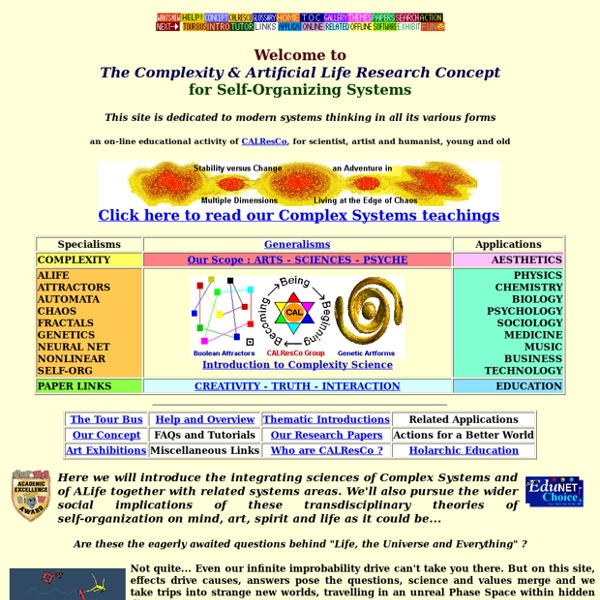



Complex systems tutorial Jan Burian burianj (at) vse.cz You can find here: Basic introduction to Complex Systems Science and relevant modeling tools Many links to web resources and a list of relevant literature "Complex systems" (4IZ636), lecture on University of Economics, Prague Content Intuitive definitions of complexity Basics of (complex) systems science Self-organization and related concepts Formal definitions of complexity Very short introduction to modeling methodology Cellular automatons Complex networks Agent-based models References Intuitive Definitions of Complex Systems System is an entity in terms of parts and relations between them. Structural relations define which parts are connected together. Structurally complex system A system that can be analyzed into many components having relatively many relations among them, so that the behavior of each component can depend on the behavior of many others. Basics of (complex) systems science Remember: Interconnection of parts matters in complex systems! Feedback
Indian Defence Review Geology.com: News and Information for Geology & Earth Science Fallacy of systems thinking and reversing the productivity game The problem with productivity enthusiasts these days, is that they will pay more attention to the hacks and tricks, than doing the actual work. We’ve created this “work masturbation” environment, where doing it better is more important than doing it at all. The problem lies with the saturation of the marketers in the field. They are creating all these artificial needs, like systems, and gadgets, in order to sustain themselves and their continuous work. First you need wake up to the truth… …that system is irrelevant. You are justifying your procrastination by doing what has perceived notion of urgency, instead of doing what is important. The habit of mindfulness and it’s impact on productivity For a long while I was procrastinating on mindfulness, it sounded to me like yet another fad. As any other addiction, procrastination can be cured by being completely mindful of what you are doing in any given time. Brain patterns and Mindfulness Some thoughts for the system thinkers
LessWrong 2.0 3quarksdaily: Why I don’t agree that systems thinking is a ‘fallacy’ It’s been some time since I wrote my counterpoint to Bojan’s article on quitting GTD, and in that time I’ve come to know him a great deal better, to respect his opinion, and I consider him a friend. However when I read his latest post on the fallacy of systems thinkers I felt compelled to lay out the things I disagree with, and to defend what I see as my position as one of the ‘systems thinkers’ he refers to. Here’s the case for the defence: Exhibit A: The Review process ‘doesn’t work’ Bojan says that for the ‘majority’ of people, the review part of productivity systems is a ‘complete disaster’. Whilst it’s hard to dispute that many people (including me) find the review aspect of GTD tough, I think it’s worth considering two points: Not all productivity systems require a ‘review’ in the same way that GTD does. I would add that there are a lot (I’d love to know the numbers) of people for whom GTD, and the review process, has been incredibly helpful. I say the exact opposite. Of course not.
YouTube to MP4 & MP3 Converter - ClipConverter.cc Brain Pickings Systems Analysis Interesting Web Sites List Systems Analysis Web Sites General Systems Analysis Links Systems and Systems Thinking Definition of a System A system definition courtesy of the Pentagon. Horizonwatching: A Smarter Planet --- aka a system! Systems and Systems Thinking Dr. Benefits of Systems Analysis Product Design by Business Week Systems Theory at work: Using a Complex Systems Approach to Study Educational Policy Horizonwatching: A Smarter Planet --- aka a system! MetaPlanning Victorian Data Processing Modern Systems Analyst Don Norman's website. International Institute for Applied Systems Analysis Web-based Information Systems Hospital begins process by re-examining patient experience Places to Intervene in a System Systems Analysis for Beginners To Combat Terrorism, a Systems Approach is Vital -- read the article. Systems Analysis: A Tool to Understand and Predict Terrorist Activities Systems Thinking at Wikipedia Systems Thinking from MIT VIDEO: Warriors of the Net An Example Systems Analysis Humor in Systems Analysis IDE-O comes to St.
Print Friendly & PDF (202) What are the most productive ways to spend time on the Internet? SystemsWiki Sleepwalking Toward Armageddon In his speech responding to the horrific murder of journalist James Foley by a British jihadist, President Obama delivered the following rebuke (using an alternate name for ISIS): ISIL speaks for no religion… and no faith teaches people to massacre innocents. No just God would stand for what they did yesterday and what they do every single day. ISIL has no ideology of any value to human beings. Their ideology is bankrupt…. we will do everything that we can to protect our people and the timeless values that we stand for. May God bless and keep Jim’s memory. In his subsequent remarks outlining a strategy to defeat ISIS, the President declared: Now let’s make two things clear: ISIL is not Islamic. As an atheist, I cannot help wondering when this scrim of pretense and delusion will be finally burned away—either by the clear light of reason or by a surfeit of horror meted out to innocents by the parties of God. But it remains taboo in most societies to criticize a person’s religious beliefs.